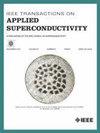Experimental Study on No-Insulation HTS Coil With Solder-Free Lap Joint Inserted
IF 1.7
3区 物理与天体物理
Q3 ENGINEERING, ELECTRICAL & ELECTRONIC
引用次数: 0
Abstract
This article presents a method for fabricating high-temperature superconducting (HTS) coils that does not require any soldering. No-insulation (NI) winding technique was used to fabricate double-pancake (DP) HTS coils with a “contact lap joint,” which is a lap joint without any soldering. The coils were cooled to 77 K in a liquid nitrogen bath and tested for performance using measurements of terminal voltage and central magnetic field. We also applied a lumped-circuit model to the coils to estimate key magnet parameters, including critical current, n-value, and joint resistance. Finally, we discussed the relationship between winding stress and joint resistivity, as well as the Joule heat dissipation caused by the contact lap joint.求助全文
约1分钟内获得全文
求助全文
来源期刊

IEEE Transactions on Applied Superconductivity
工程技术-工程:电子与电气
CiteScore
3.50
自引率
33.30%
发文量
650
审稿时长
2.3 months
期刊介绍:
IEEE Transactions on Applied Superconductivity (TAS) contains articles on the applications of superconductivity and other relevant technology. Electronic applications include analog and digital circuits employing thin films and active devices such as Josephson junctions. Large scale applications include magnets for power applications such as motors and generators, for magnetic resonance, for accelerators, and cable applications such as power transmission.
 求助内容:
求助内容: 应助结果提醒方式:
应助结果提醒方式:


